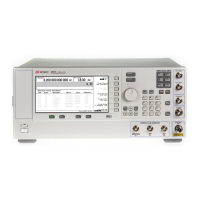E8257D/67D, E8663D PSG Signal Generators Service Guide
Troubleshooting
Troubleshooting Option UNR/UNX/UNY and Instruments with Serial Prefixes >= US4805/MY4805 Phase Noise
1-82
Troubleshooting Option UNR/UNX/UNY and Instruments with Serial
Prefixes >= US4805/MY4805 Phase Noise
Poor grounds or shielding problems in either the test environment or the measurement system can cause the phase
noise measurement to fail. Physical vibration is another common cause of phase noise. Before performing a phase
nose measurement make sure all covers are installed, the work surface is free of physical vibrations, and the phase
noise system is working properly.
Phase noise failures at specific offsets are fairly predictable. After making sure the measurement accurately reflects a
failure, use Table 1- 29 to troubleshoot phase noise problems. The troubleshooting procedure consists of assembly
substitution.
NOTE In non–Option UNR/UNX and instruments with serial prefixes > US4805/MY4805, the most likely assemblies
and frequency offset are the same except for <100 Hz. In non–Option UNR/UNX and instruments with serial
prefixes > US4805/MY4805, the most likely assembly for <100 Hz offset is the A7 Reference.
Sampler Spurs These spurs are generated on the A5 Sampler by the sampler LO and IF
frequencies.
Frac–N 250 MHz
Crossing Spurs
These spurs are generated by either the A5 Sampler, A6 Frac–N, or A7 Reference.
They occur when a harmonic of the Frac–N frequency equals a harmonic of
250 MHz. The spurs are measured in highband at 133 kHz offset from the CW
frequency.
IF 250 MHz Crossing
Spurs
These spurs are generated on the A5 Sampler. They are caused by harmonics of
the A5 Sampler IF. The spurs are measured in highband at 133 kHz offset from the
CW frequency.
Table 1-29 Phase Noise Failures
Frequency Offset Most Likely Assembly
0 to 100 Hz A32 High Stability Time Base
100 Hz to 10 kHz A7 Reference
<5 kHz to 10 kHz A6 Frac–N; A45 Frac- N (Option UNY)
10 kHz to 100 kHz A5 Sampler; A46 Offset (Option UNY)
>100 kHz to 1 MHz A28 YIG Oscillator or A9 YIG Driver
Frequencies <3.2 GHz A8 Output
Frequencies >3.2 GHz A29 20 GHz Doubler or A30 Modulation Filter
Frequencies >20 GHz A27 40 GHz Doubler
Table 1-28 Non Harmonic Spurs (Continued)

